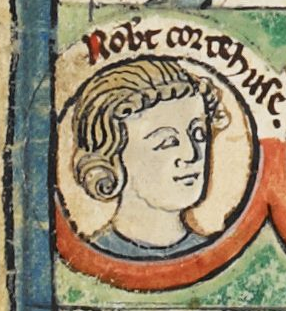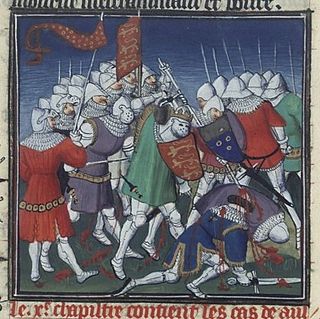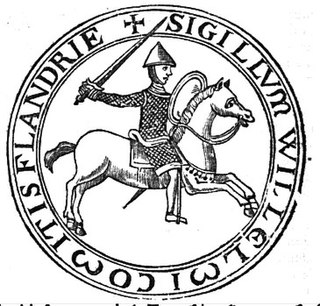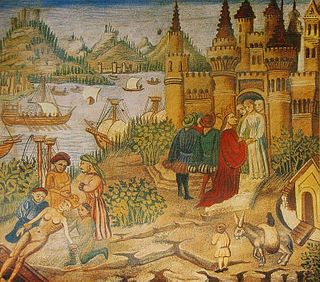Related Research Articles

Edgar Ætheling or Edgar II was the last male member of the royal house of Cerdic of Wessex. He was elected King of England by the Witan in 1066 but never crowned.

Robert Curthose, was the eldest son of William the Conqueror and succeeded his father as Robert II of Normandy in 1087, reigning until 1106.

The Battle of Tinchebray took place on 28 September 1106, in Tinchebray, Normandy, between an invading force led by King Henry I of England, and the Norman army of his elder brother Robert Curthose, the Duke of Normandy. Henry's knights won a decisive victory: they captured Robert, and Henry imprisoned him in England and then in Wales until Robert's death in 1134.

Robert I of Normandy, also known as Robert the Magnificent and by other names, was a Norman noble of the House of Normandy who ruled as duke of Normandy from 1027 until his death in 1035. He was the son of Duke Richard II; the brother of Duke Richard III, against whom he unsuccessfully revolted; and the father of Duke William who became the first Norman king of England after winning the Battle of Hastings in 1066. During his reign, Robert quarrelled with the church—including his uncle Robert, archbishop of Rouen—and meddled in the disorder in Flanders. He finally reconciled with his uncle and the church, restoring some property and undertaking a pilgrimage to Jerusalem, during which he died.

William Clito was a member of the House of Normandy who ruled the County of Flanders from 1127 until his death and unsuccessfully claimed the Duchy of Normandy. As the son of Robert Curthose, the eldest son of William the Conqueror, William Clito was seen as a candidate to succeed his uncle King Henry I of England. Henry viewed him as a rival, however, and William allied himself with King Louis VI of France. Louis installed him as the new count of Flanders upon the assassination of Charles the Good, but the Flemings soon revolted and William died in the struggle against another claimant to Flanders, Thierry of Alsace.

Robert, Count of Mortain, first Earl of Cornwall of 2nd creation was a Norman nobleman and the half-brother of King William the Conqueror. He was one of the very few proven companions of William the Conqueror at the Battle of Hastings and as recorded in the Domesday Book of 1086 was one of the greatest landholders in his half-brother's new Kingdom of England.
Robert de Bellême, seigneur de Bellême, seigneur de Montgomery, viscount of the Hiémois, 3rd Earl of Shrewsbury and Count of Ponthieu, was an Anglo-Norman nobleman, and one of the most prominent figures in the competition for the succession to England and Normandy between the sons of William the Conqueror. He was a member of the powerful House of Bellême.
Alan III of Rennes was Count of Rennes and duke of Brittany, by right of succession from 1008 to his death.

William de Warenne, 2nd Earl of Surrey was the son of William de Warenne, 1st Earl of Surrey and his first wife Gundred. He was more often referred to as Earl Warenne or Earl of Warenne than as Earl of Surrey.

Bertrade of Montfort, also known by other names, was a Norman noble from the House of Montfort. She was countess of Anjou (1089–1092) through her first marriage to Fulk the Rude and then queen consort of France (1092–1108) through her initially bigamous marriage to Philip I. Condemned in her era's ecclesiastical histories, she played a role in the popularization of pigache footwear and founded a daughter house of Fontevraud Abbey at Hautes-Bruyeres.

Helias of Saint Saëns (?–1128), Count of Arques was a Norman magnate of the eleventh and twelfth century, a loyal supporter of Robert Curthose and protector of his son William Clito. His support of the latter eventually brought him into conflict with Henry I of England, ending in his willing exile from Normandy.
Herbert II was Count of Maine from 1051 to 1062. He was a Hugonide, son of Hugh IV of Maine and Bertha of Blois.
Richard de Courcy was a Norman nobleman and landholder in England.

Thomas FitzStephen was captain of the ill-fated White Ship, which sank off Barfleur, Normandy, on 25 November 1120.

St William of Breteuil or William de Breteuil was a Norman abbot and magnate who held extensive lands in central Normandy as the lord of Breteuil at the end of the reign of King William I and during the chaotic period afterwards when William's eldest son Robert Curthose, duke of Normandy, contested with his younger brother William Rufus, king of England. Upon the death of William Rufus while hunting in the New Forest, Lord William attempted—but failed—to block Prince Henry seizing the crown jewels from the Winchester treasury and declaring himself king in preference to the crusading Robert. Lord William was later abducted and tortured by a French noble who wanted to marry his illegitimate daughter Isabel. He is venerated as a saint in the Roman Catholic Church.
Walter Giffard, Lord of Longueville in Normandy, 1st Earl of Buckingham was an Anglo-Norman magnate.
Richard of Montfort or Richard de Montfort was a French nobleman from the House of Montfort who briefly ruled as lord of Montfort (1089–1091) in Normandy. He took the part of Count William of Évreux during his private war with Raoul II, lord of Conches. As Richard had no children at the time of his death, the lordship passed to his brother Simon II.

Sibylla of Conversano was a wealthy Norman heiress, Duchess of Normandy by marriage to Robert Curthose. She was regent of Normandy during the absence of her spouse.
Ralph of Gacé was a member of the House of Normandy who played an influential role during the minority of William the Bastard, prior to his conquest of England. Ralph was the lord of Gacé and other estates in Normandy.
William of Évreux or William d'Évreux was a member of the House of Normandy who played an influential role during the Norman conquest of England, one of the few Norman aristocrats documented to have been with William I at Hastings. He was the count of Évreux in Normandy as well as additional lands and expanded his holdings by consenting to the marriage of his young ward and niece Bertrade to Fulk the Rude of Anjou, whose support against the Manceaux rebels was important for William's liege Robert Curthose. A feud between William's wife Helvise or Heloise of Nevers and Isabel of Conches, the wife of Raoul II of Tosny, led to open war between the two men. Helvise also governed Évreux in William's infirm old age until her own death. Having no children of his own, William was succeeded at Évreux by his sister's son Amaury of Montfort.